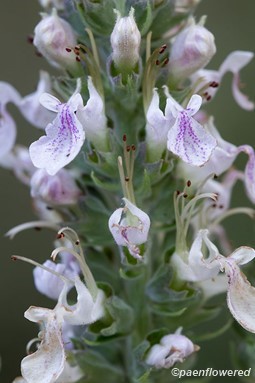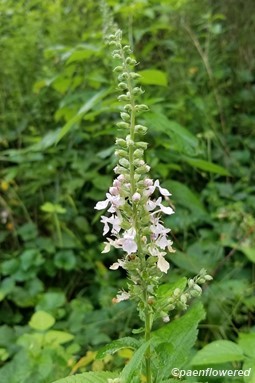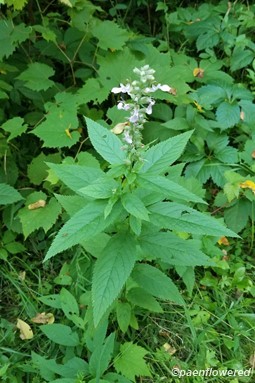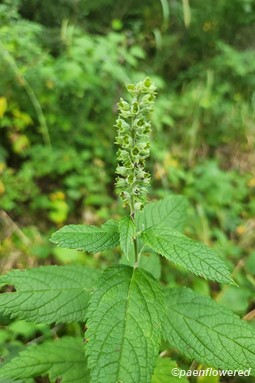Teucrium canadense
Pubescent rhizomatous perennial with purplish to pink flowers in spike-like racemes
Teucrium canadense wild germander
This native perennial wildflower is a member of the mint family and grows one to three feet high. It has a terminal spike-like cluster of lavender to pinkish white flowers that are each about ¾ inch long. It is the shape of the individual blossom that is most unique. Like most mints, the germander has a corolla with five lobes. On this plant, however, the lower lobe is long, extends horizontally and has an elaborate structure. The other lips are considerably reduced in size. Between two of these small upper lips are four long curled anthers that look like stalked eyes or antennae. These grow through a slit in the upper lip. (This can best be seen on the flower on the left side of the cluster)
From the front the flower resembles an orchid. The large lower lip serves as a landing pad for pollinating animals: long-tongued bees, some flies, butterflies, and skippers. Other pollinators like hummingbirds and hummingbird moths do not use the platform. As pretty as the flowers are, they have no scent. The flowers grow on a vertical spike and bloom from bottom to top.
The oval to lance-shaped leaves of the germander are two to four inches long, opposite, toothed and hairy on the underside. They are grey-green in color. The germander blooms from June to September and is found throughout the United States. It grows 8-36 inches tall. Like most mints the stem is square.
This species is found in woods, shorelines, thickets, ditches and abandoned fields. Each flower produces four seeds. The plant also has a rhizome that spreads the plant asexually, producing clumps of identical plants. The bitter taste of the leaves discourages a lot, but not all, animals from feeding on the plant.
Native Americans used the leaves to make medicinal teas. Leaves were also steeped in water for use in healing sores and ulcers of the skin. It is also called the Canadian germander and the hairy Germander. Two European germanders are also found here. One has yellow flowers and the other is an annual with purple flowers.
Habitat & Range
Moist fields, lake shores, flood plans.
Present throughout the state.
| EMP: | FACW |
|---|---|
| NCNE: | FACW |
Phenology
Flowers June to August.
Plant Codes
S-rank: No rank
G-rank: G5 (Secure)










Comments
Have you spotted this plant in your area? We'd love to hear about your experience! Share your comments or questions about the plant below. Comments are moderated before posting.